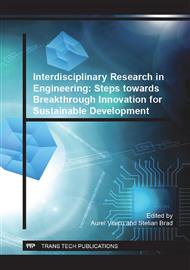[1]
D. Antoni, V.V. Zverlov, W.H. Schwarz, Biofuels from microbes, Appl. Microbiol. Biotechnol. 77 (2007) 23 – 35.
DOI: 10.1007/s00253-007-1163-x
Google Scholar
[2]
B.F. Pain, R.Q. Hepherd, Anaerobic digestion of livestock wastes, in: B.F. Pain, R.Q. Hepherd (Eds. ), Anaerobic Digestion of Farm Waste, NIRD Technical Bulletins Reading, 1985, p.9–14.
Google Scholar
[3]
J. Mata-Alvarez, Biomethanization of the Organic Fraction of Municipal Solid Wastes, IWA Publishing, London, (2002).
Google Scholar
[4]
L. Sahlstrom, A review of survival of pathogenic bacteria in organic waste used in biogas plants, Bioresour. Technol. 87 (2003) 161–166.
DOI: 10.1016/s0960-8524(02)00168-2
Google Scholar
[5]
E. Smet, H. Van Langenhove, I. De Bo, The emission of volatile compounds during the aerobic and the combined anaerobic/aerobic composting of biowaste, Atmos. Environ. 33 (1999) 1295–1303.
DOI: 10.1016/s1352-2310(98)00260-x
Google Scholar
[6]
S. Tafdrup, Viable energy production and waste recycling from anaerobic digestion of manure and other biomass materials, Biomass Bioenerg. 9 (1995) 303 – 314.
DOI: 10.1016/0961-9534(95)00098-4
Google Scholar
[7]
S. Rasi, A. Veijanen, J. Rintala, Trace compounds of biogas from different biogas production plants. Energy 32 (2007)1375–1380.
DOI: 10.1016/j.energy.2006.10.018
Google Scholar
[8]
K.V. Lo, P.H. Liao, A.C. March, Thermophilic anaerobic digestion of screened dairy manure. Biomass 6 (1985) 301–315.
DOI: 10.1016/0144-4565(85)90055-1
Google Scholar
[9]
M. Dupla, T. Conte, J.C. Bouview, N. Bernet, J.P. Steyer, Dynamic evaluation of a fixed bed anaerobic-digestion process in response to organic overloads and toxicant shock loads, Water Sci. Technol. 49(1) (2004) 61–68.
DOI: 10.2166/wst.2004.0019
Google Scholar
[10]
B. Demirel, P. Scherer, The roles of acetotrophic and hydrogenotrophic methanogens during anaerobic conversion of biomass to methane: a review, Rev. Env. Sci. Biotechnol. 7 (2008) 173–190.
DOI: 10.1007/s11157-008-9131-1
Google Scholar
[11]
R. Einspanier, B. Lutz, S. Rief, O. Berezina, V. Zverlov, W.H. Schwarz, J. Mayer, Tracing residual recombinant feed molecules during digestion and rumen bacterial diversity in cattle fed transgene maize, Eur. Food Res. Technol. 218 (2004).
DOI: 10.1007/s00217-003-0842-9
Google Scholar
[12]
H.D. Ariesyady, T. Ito, S. Okabe, Functional bacterial and archaeal community structures of major trophic groups in a fullscale anaerobic sludge digester, Water Res. 41 (2007)1554–1568.
DOI: 10.1016/j.watres.2006.12.036
Google Scholar
[13]
C.A. O'Sullivan, P.C. Burrell, W.P. Clarke, L.L. Blackall, Structure of a cellulose degrading bacterial community during anaerobic digestion, Biotechnol. Bioeng. 92 (2005) 871–878.
DOI: 10.1002/bit.20669
Google Scholar
[14]
K. Syutsubo, Y. Nagaya, S. Sakai, A. Miya, Behavior of cellulose degrading bacteria in thermophilic anaerobic digestion process, Water Sci. Technol. 52 (2005) 79–84.
DOI: 10.2166/wst.2005.0501
Google Scholar
[15]
R. Krishna Prasad, S.N. Srivastava, Electrochemical degradation of distillery spent wash using catalytic anode: Factorial design of experiments, Chem. Eng. J. 146 (2009) 22-29.
DOI: 10.1016/j.cej.2008.05.008
Google Scholar
[16]
V. Ponnusami, V. Krithika, R. Madhuram, S.N. Srivastava, Biosorption of reactive due using acid-treated rice husk: Factorial design analysis, J. Hazard. Mat. 142 (2007) 397-403.
DOI: 10.1016/j.jhazmat.2006.08.040
Google Scholar
[17]
D. Bingol, N. Tekina, M. Alkan, Brilliant Yellow dye adsorption onto sepiolite using a full factorial design, Appl. Clay Sci. 50 (2010) 315-321.
DOI: 10.1016/j.clay.2010.08.015
Google Scholar
[18]
K. Palanikumar, J.P. Dawim, Assessment of some factors influencing tool wear on the machining of glass fibre-reinforced plastics by coated cemented carbide tools, J. Mater. Process Technol. 209 (2009) 511–519.
DOI: 10.1016/j.jmatprotec.2008.02.020
Google Scholar


